Juggling and Flow
Below is an article that first appeared in the Jul/Aug 2000 issue of JUGGLE magazine.
Juggling and Flow
Many jugglers talk about the therapeutic, almost meditative state they experience while juggling. It is not uncommon for people to keep three bean bags in their desk at work and take juggling breaks. After juggling, they notice they are refreshed and alert, better able to get the work done.
The exact nature of this inner experience associated with juggling is difficult to pin down. One approach to furthering discussion may be to utilize the concept of flow, developed by Mihalyi Csikszentmihalyi, Department of Psychology Professor at the University of Chicago. (Note: Dr. Csikszentmihalyi passed in 2021.)
The Qualities of Flow
One characteristic of flow is that a person is challenged by an activity while not being overwhelmed by it. There is a goal-directed, rule-bound action system providing feedback to the participant, so that he or she knows how s/he is performing. In flow, one's concentration is so focused that there is no attention left to think about irrelevant concerns or problems. Self-consciousness tends to disappear.
People report a distorted time sense. While an outsider may see a frantic pace, the participant engaged in flow senses that time has slowed down, allowing ample time to do what is necessary. Activities that provide access to this state of flow are so gratifying that people will engage in them for their own sakes, not just for external rewards.
It is possible to be in a state of flow during one's leisure time, or while at work. People who experience flow while at work report an increased autotelic attitude towards their jobs. "Surgeons speak of their work: 'It is so enjoyable that I would do it even if I didn't have to.'"1
When describing optimal experience in this book, we have given as examples such activities as making music, rock climbing, dancing, sailing, chess, and so forth. What makes these activities conducive to flow is that they were designed (italics in the original) to make optimal experience easier to achieve. They have rules that require the learning of skills, they set up goals, they provide feedback, they make control possible. They facilitate concentration and involvement by making the activity as distinct as possible from the so-called "paramount reality" of everyday existence.2
People in a state of flow report experiencing an increased sense of awareness, confidence and ability. The idea of taking a juggling break at work, or while studying seems most beneficial.
While Csikszentmihalyi did not develop these ideas with juggling in mind, the fit seems to match. The flow model recognizes that jugglers bring different abilities and skills to their sessions. Depending on the individual challenge (or lack of, in relation to the individuals' abilities) offered by the task, jugglers may feel either bored, anxious, or motivated. While it may not be possible in all cases, the flow model offers jugglers to a technique to design their sessions to match and elevate their psychological moods.
An Explanation of the Flow Model
While not clarifying specifics, the flow diagram provides an approach on how to gauge the different components of the learner assignment in a training program. By looking at specific skills through the model one can adjust the difficulty level to find appropriate tasks and techniques.
A simple X-Y graph helps to visualize our concept of flow (fig. 1). Along the horizontal axis we can plot the ability of the juggler. Someone farther out to the right is better than someone closer to zero. The vertical axis represents the difficulty of the activity. The task gets harder as one goes higher.
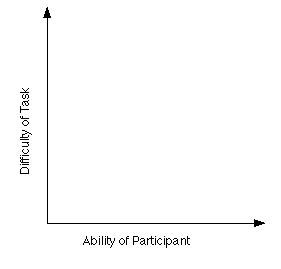
figure 1
Three points placed on the graph represent the three different states of mind that are possible (fig. 2). Point A represents a highly skilled juggler throwing a pattern that is not very challenging. That person is most likely experiencing boredom.
Point B shows someone who isn't too good attempting a difficult pattern. That juggler would be frustrated or anxious.
Point C shows a juggler of moderate ability who has a pattern of average difficulty. This person has the potential to experience flow. He or she is challenged by the activity without being overwhelmed by it. The important thing to note here is that the ability of the participant matches the difficulty of the task.
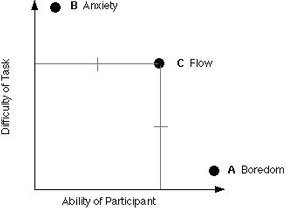
figure 2
Wherever the level of difficulty matches the ability of the participant we can mark a point and call it flow. All of these flow points can be connected to make a continuous, diagonal line (fig. 3). It is important to note that all jugglers, from beginner to experts, have access to this flow line. One must merely find an appropriate task that matches that one's strengths and weaknesses. As a beginner becomes more experienced and adept, the activity must become more challenging. If not, the novice will become bored. People who aren't that skilled will be frustrated unless the task is made a little easier.
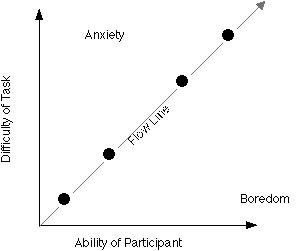
figure 3
In this sense the model can be used to match jugglers with appropriate tasks and/or learning activities. One of the great appeals of juggling is the wide variety of props and skills to work on. Frustrated with the Four Ball Mills Mess? Try playing around with cigar boxes for a while. Even the most proficient juggler will never be bored. One can always add one more ball to the pattern to increase the difficulty level.
Taking another look at Figure 3, flow can be called the state of mind that exists between boredom and anxiety. All four jugglers represented by the four dots are experiencing flow. They may not be working on the same things. They may not have the same skill level. However, each one may be equally involved in whatever activity he or she is pursuing.
Surprisingly, flow may also occur when two or more jugglers with different abilities are involved in the same activity. Take club passing as an example. Advanced passers may be in a state of flow while throwing all sorts of wild tricks to a beginning passer. A novice passer will be challenged trying to catch all the clubs that are coming in from different angles. Both will be in a state of flow.
Ability on the graph refers to any type of ability. It is possible to add a Z axis zooming out of the page at a right angle to make this graph three dimensional (fig. 4). In each plane of this new third dimension we could define the participant's particular ability and particular challenge. Looking at the different abilities represented by the separate planes can help provide a juggler with an overall idea of his or her strengths and weaknesses for a prop or variation.
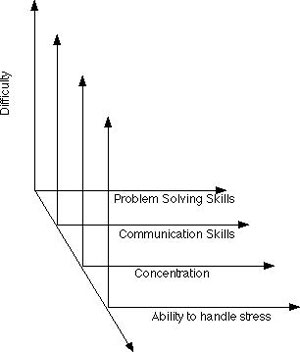
figure 4
There is a social aspect to flow and enjoyment. While it is possible to enter into flow as a solitary experience, many people report that they attain flow more easily and frequently when they are in social settings. Thus, the flow line is perhaps better represented as a flow channel (fig. 5). The camaraderie of being around other jugglers who are enjoying themselves may be enough stimulus to move someone from the boredom zone into the flow channel. At the same time, the enthusiasm and support of friends, family or co-workers may prevent someone else's anxiety from becoming too great to keep them out of the flow channel. Perhaps this is why juggling festivals have become so popular. It is easier to get into a flow state when juggling around other enthusiasts.
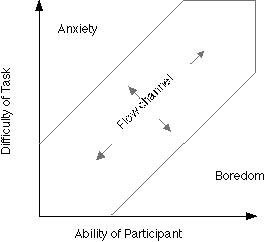
figure 5
Implications for jugglers
Are you experiencing flow while juggling? If not, you may be able to use some of Csikszentmihalyi's ideas to make your juggling sessions more satisfying. Bored? Try something a bit more challenging. Frustrated? Work on an easier pattern for a while.
Getting feedback while juggling is a fairly straightforward process. Generally, if things aren't falling to the ground, one is having success. You can look for more subtle feedback. Are your muscles relaxed or cramped? How is your breathing? Tuning in to and adjusting for these subtle distinctions may make your sessions more productive and mentally rewarding.
Do you have clear goals and procedures for attaining your juggling goals? According to Csikszentmihalyi, setting goals is conducive to attaining a state of flow.
Does flow lead to better juggling skills? Perhaps. While no controlled studies have been carried out, anecdotal evidence suggests that the increased focus when juggling in a state of flow leads to more rapid and deeper improvement. If you would like to keep your juggling sessions fresh and invigorating, while learning new patterns and techniques more quickly, consider setting up conditions conducive to attaining flow.
copyright 2000 by Todd Strong
Books on Flow by Mihaly Csikszentmihalyi
Flow : The Psychology of Optimal Experience
Paperback - 303 pages Rep edition (March 1991)
HarperCollins
Beyond Boredom and Anxiety
Hardcover - 256 pages (April 2000)
Jossey-Bass Publishers; ISBN: 0787951404
Below is a photo of the author after a New Games workshop.
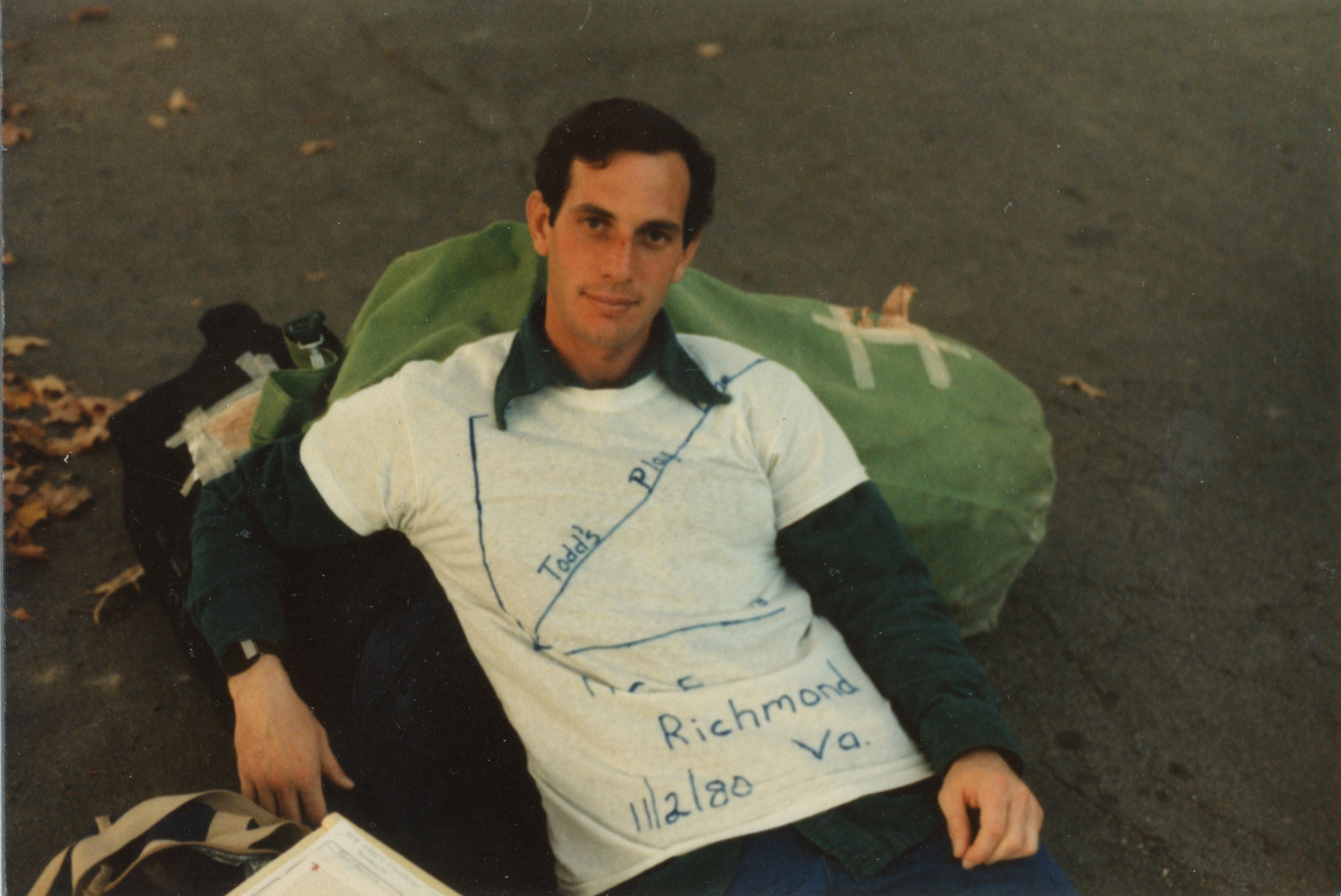

- Home
- About
- Ball Juggling
- Cigar Boxes
- Club Juggling
- Club Swinging
- Comedy Writing
- Cup Stacking
- Devil Sticks
- Diabolo
- Diabolo Postcards
- Dice Stacking
- Hat Manipulation
- Lasso
- Miscellanous Juggling
- Parachute Games
- Poi Swinging
- Ring Juggling
- Shaker Cups
- Skill Games
- Staff
- Tennis Balls and Can
- New Games Foundation
- Ordering and Shipping
- Contact Information
- Peeps (photos of birds and stuff)
- Personal Thoughts
- Workshops
- Links
- Questions? Comments? Feedback?